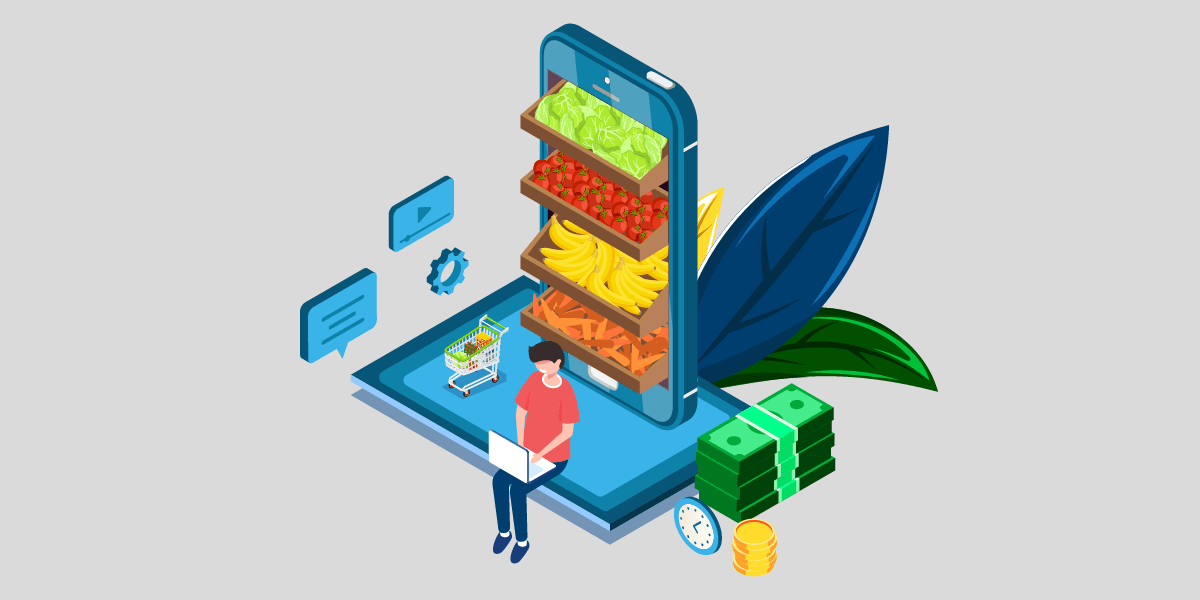How Much Does On-Demand Grocery App Development Costs?
The ease of getting your everyday need’s items delivered at your doorstep is a heaven that is not just appreciated by the many customers who order them on-demand but also a myriad of entrepreneurs who wish to be a hotshot in the flourishing market.
And no matter what class these aspirational entrepreneurs belong to, the question that they all have in mind is How much does on-demand grocery app development costs. One which we will be dissecting into today.
But before that, what exactly is it about the grocery delivery market that is attracting the businesses and investors (as we will see later) to them?
Well, for many it is the business model that the many types of grocery apps operates within.
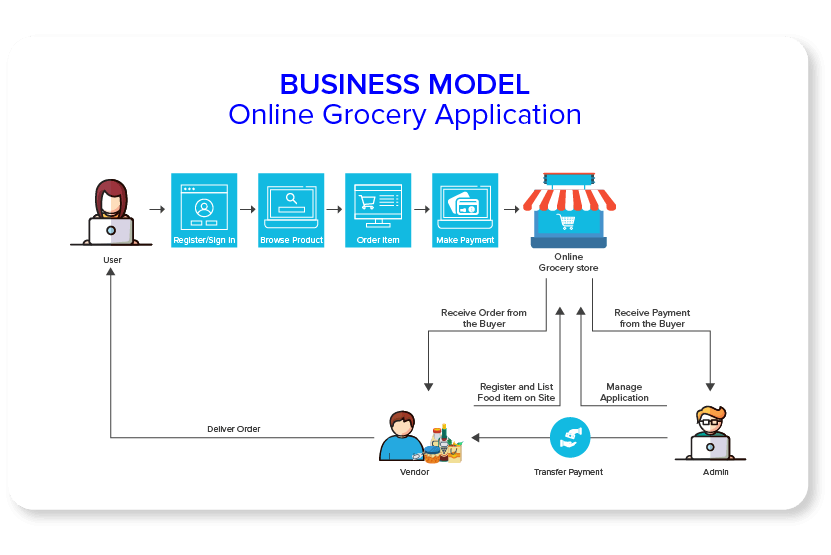
For a domain whose business model looks as easy as 1-2-3, the attention that the market is getting from the world full of customers and investors is remarkable.
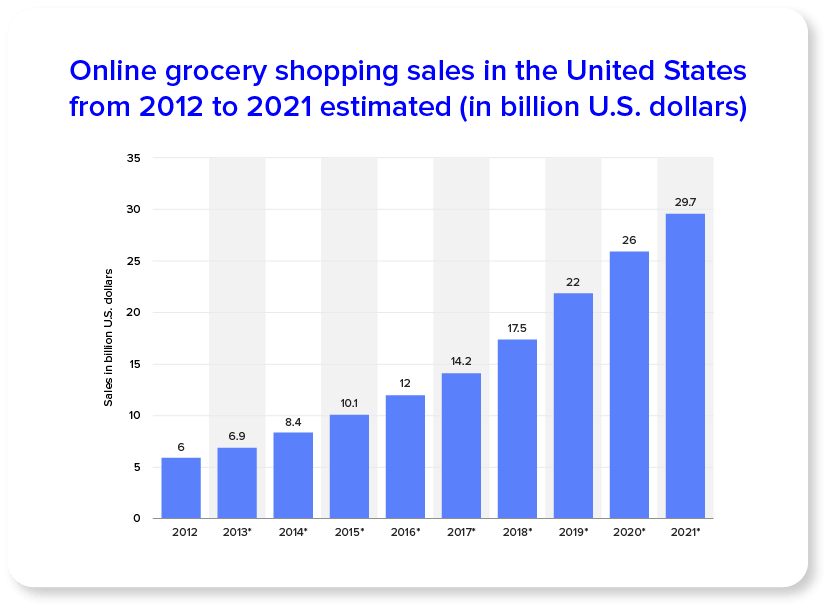
The positive outlook that the industry is witnessing – in terms of the projected growth chart – from the ever-increasing user base and the entrepreneurs willing to enter the flourishing domain is partially the doing of user demand and partially the doing of the increasing funding rounds that the domain is seeing – something that is also carrying an indirect impact on the cost to develop a grocery delivery app.
Either way, the number of players entering the domain is, in fact, growing at a high rate with the top guns’ position changing every passing day. Well, on the present day if you enter the domain, your personalized on-demand grocery delivery app will have to compete with –
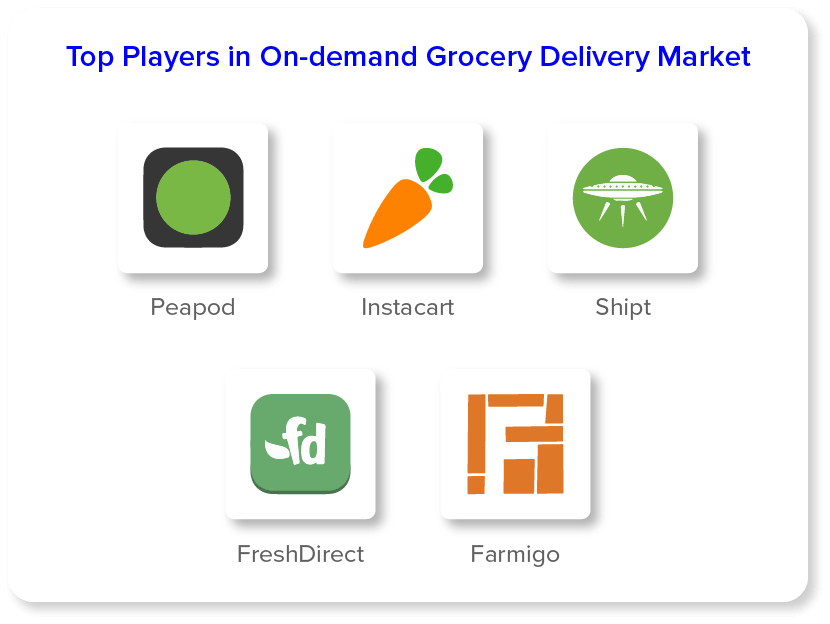
With the market scenario now groped, before we move on to the sections where we get you acquainted with the ground level parts of starting your on-demand grocery business and get you a answer to Cost of making on-demand grocery app, let us first give you a peek into the market you are going to enter from the investments and fund front.
Recent Expansion and Funding in the Grocery Delivery Industry
Well here are the expansions and fundings that have happened in the grocery delivery market in the recent time –
A. The supermarket chain, Lidl has expanded its on-demand grocery delivery service to Ireland (earlier it was restricted to Dublin) and has plans to extend it to Newbridge.
B. Kurly, the grocery delivery service in Korea closed a Series E funding round which reached somewhere around $160 Million, in May 2020.
C. Amazon, invested in online delivery company Deliveroo to help them expand in the grocery delivery market – A move that has now strengthened its foothold in the grocery market ever since the launch of Amazon Go has been announced.
Now that we have looked at the funding situation that is presently operative in the domain, it is time to get down to the ground-level parts of entering the grocery delivery market through an on-demand application.
Let us start with the Features first – the primary thing to help understand How do you make an online grocery app?. The features that would play a strong role in deciding not just how your app would function but also would help answer how much does grocery app development costs.
The Must-Have Features of Grocery Shopping Apps
The list of features that has to be considered while looking into on demand grocery delivery app development is basically divided into three parts – every set attending to a specific stakeholder. Let us look at the feature set one after another.
List of Features in the Customers’ Side of the Application
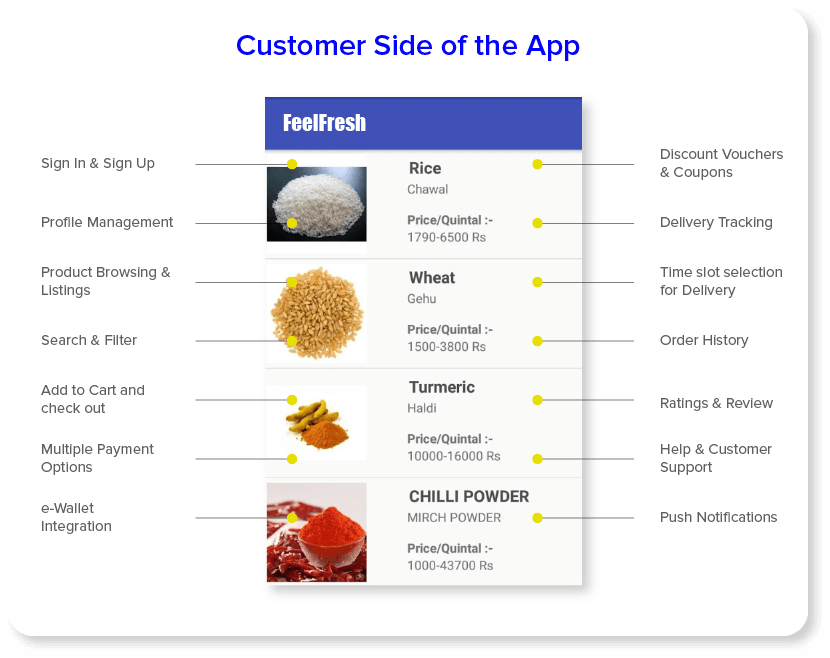
Sign In & Sign Up: The registration and sign in is the first interaction screen where the customer enters the application. Social media integration is widely used at this stage to make the whole process a whole lot easier.
Profile Management: At this stage, users are given the option to create and update their profiles which contain information related to their contact details, payment methods, etc.
Product Browsing & Listings: The on demand grocery app should have a number of products to enlist for the customers to choose from.
Search & Filter: The option should be there to enable the customers to search for something they wish to buy off your application.
Add to Cart and Check-Out: Both the functionalities should be present in the application to make the whole ordering process easier.
Multiple Payment Options: Your payment gateway integration process should allow customers to pay using multiple payment options – something that makes the whole experience comfortable for them.
e-Wallet Integration: You can also give your customers to keep some money in the in-built wallet to make the check-out process very seamless and quick.
Discount Vouchers & Coupons: Your customers should be given the ease to view and apply the discount code at the time of payment
Delivery Tracking: Real-time tracking of where the order has reached can be a functionality that can have a massive impact on the user engagement, for the customers would always be in the know-how of their products.
Time Slot Selection for Delivery: Noting the fact that groceries are mainly ordered on the on-demand note by working class of people, it is advised that you give them the freedom to choose a time-slot as per their convenience.
Order History: Customers should be given the facility to check their order purchase history inside the application to make it easy for them to remember whether or not to make a repeat order.
Ratings & Review: Your customers should be allowed to post their experience from a particular store or product on the application for others to see.
Help & Customer Support: You should give your customers a way to reach your team whenever they face any issue.
Push Notifications: When it comes to mobile app marketing, there is yet to be a mechanism as effective as a push notification. So, your app should also have a well-defined push notification strategy working for it.
List of Features in the Driver’s Side of the Application
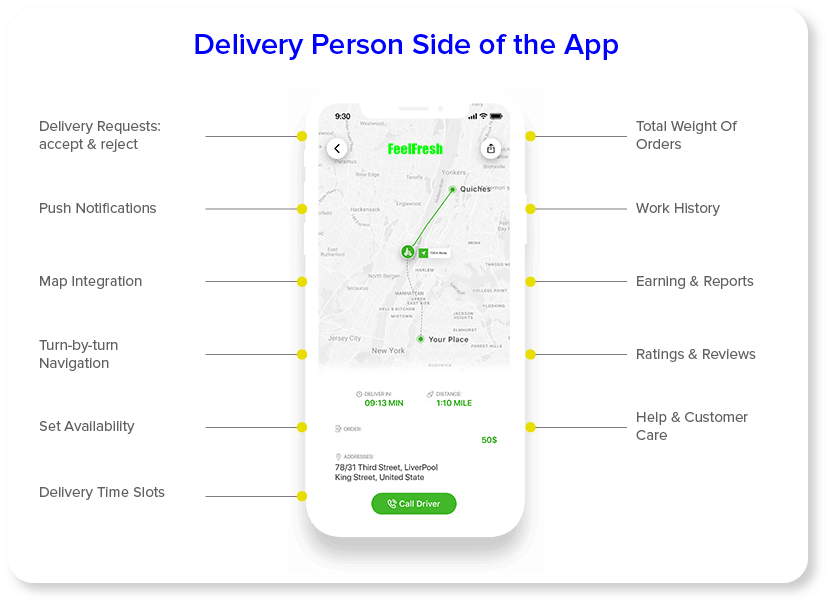
Delivery Requests: The drivers partnered with your application should be given the freedom to accept or reject a particular trip because of any reason.
Push Notifications: All the order delivery information – new and canceled along with the account debit information should be given to the drivers through push notifications.
Map Integration: A must-have part of your Grocery app feature for delivery panel would be the integration of the map to help your drivers know where is the location of the customer.
Turn-by-turn Navigation: Inside the map, you should also give the functionality to help drivers with turn by turn navigation being told out loud.
Set Availability: Drivers should be allowed to set their availability in terms of when would they be present to take the order and deliver it.
Delivery Time Slots: The time slots that the customers select should be shared with the drivers as well to help them know when to pick the order and deliver it.
Total Weight Of Orders: Because the drivers have to carry the order, they should be in the know-how of how does it weigh – so that they are able to decide on the vehicle type.
Work History: The details of the trip made should be shared with the drivers on their app so that they have a clear idea of their performance once the day ends.
Earning & Reports: The invoice and details of their complete earning should be mentioned clearly inside the application.
Ratings & Reviews: They should be given the freedom to review and rate a trip as well – after all, accountability rides on both sides.
Help & Customer Care: Just like your customers, your drivers should have clear ease of contacting your team when they face an issue.
List of Features in the Admin’s Side of the Web Application
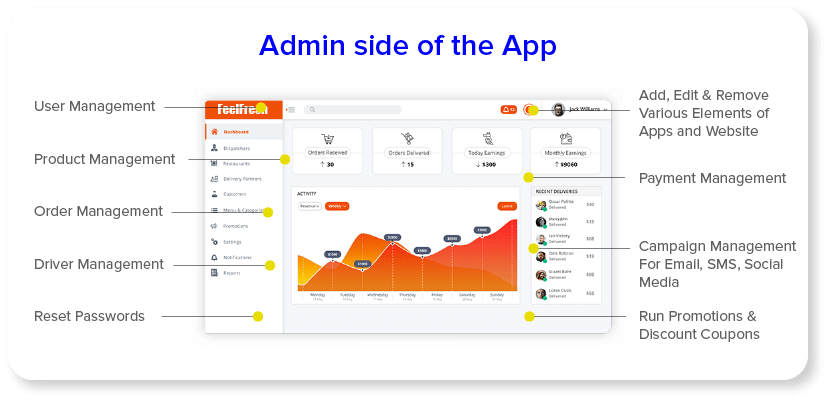
User Management: Admin of the application will have the ability to add or remove users within the application or change their active status.
Product Management: They should be able to change the add new products, remove discontinued ones and even edit their details on the page.
Order Management: Admins will have to be on top of the orders that are being made inside the application.
Driver Management: Driver management is one of the important functionalities that should be present in the admin panel. It should have complete information about the drivers – their contact information, trip details, etc.
Reset Passwords: While password reset is an option that drivers and customers will be working around, the admin should also have the database of the passwords with them.
Add, Edit & Remove Various Elements of Apps and Website: All the changes to be made inside the application – start from the users and product information to changing the design of the application – should be made easy to operate to the admin.
Payment Management: Every payment detail made inside the application including the refunds should be made available to the admins with ease.
Campaign Management For Email, SMS, Social Media: Admins should be given the necessary features to plan campaigns around SMS, email, social media, etc to attract customers to their application,
Run Promotions & Discount: The admins would be given the complete access to run discount and promotional offers across the whole application.
Now that we have looked at the list of must-have features of grocery application development, it is time to move on to the next technical part of the process that you would have to follow when starting on your on-demand grocery delivery app business – Technology Stack.
Technology Stack Used for an Efficiently Developed On-Demand Grocery App
While the technology stack used to make an on-demand grocery app might vary from business to business depending on their skill-set and the budget that they have set in name of the cost of mobile app development.
The one that our in-house team of grocery app developers has been using is –
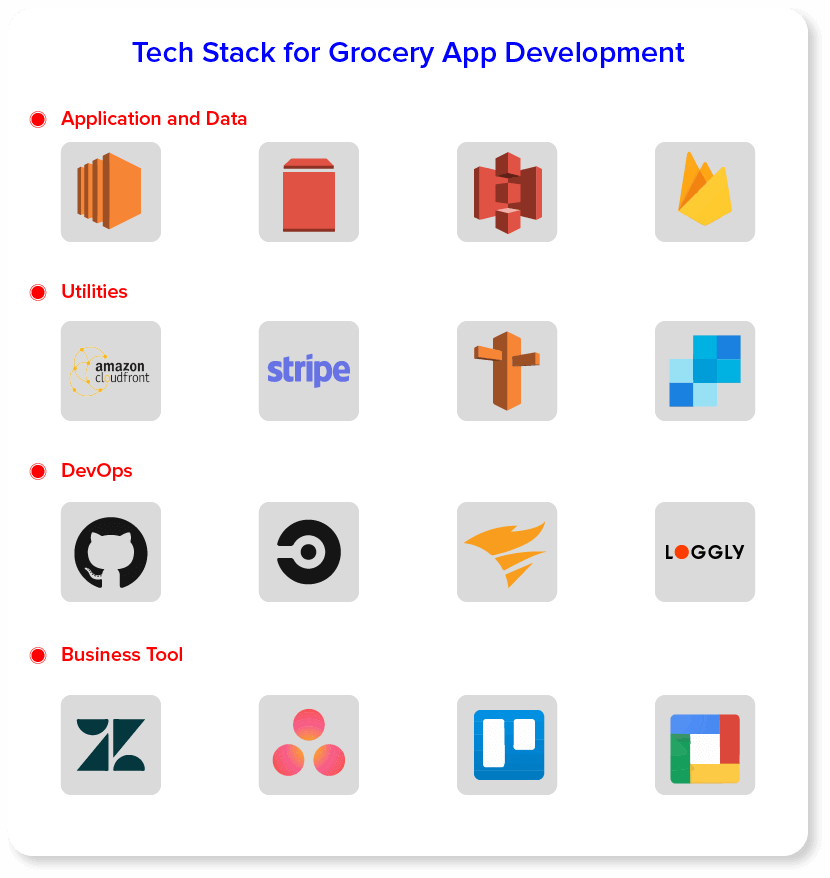
Now that we have looked at the two things that tend to have the biggest impact on the grocery app development cost, it is time to answer the question that you must be waiting to get insight on.
How Much Does Grocery App Development Costs?
The exact answer of how much does grocery app development costs is a number that we can only arrive at after analyzing your business requirement and expectations from the project.
But if you look at the feature set and the tech stack that we have mentioned above, you will get a number in the range of somewhere around USD 40K to USD 50K – including all the three app versions that we looked into above that is if you are looking to know the grocery app development cost in India.
But then again, the number can definitely vary depending on how your requirement shifts.
Well, with this we have looked at it all that you need to get started with your on-demand grocery delivery business with the support of the on demand grocery delivery app development process. The next step is to know how you would earn back the amount that went into its development.
So, to get a complete idea of what things to watch out for turning your On-demand app vision into a mobile app, you should consult with an on demand grocery delivery app development company.

strategies your digital product..
